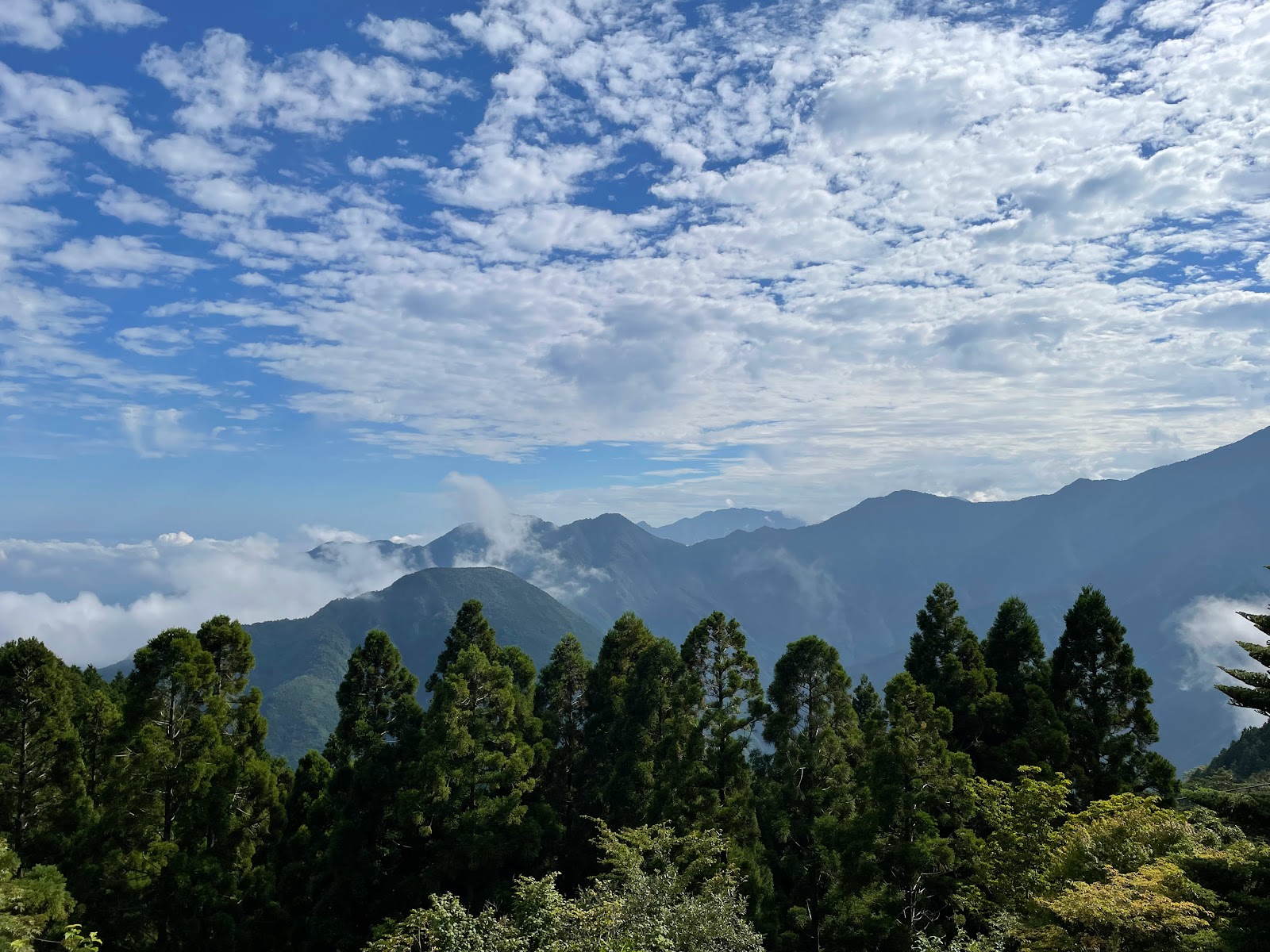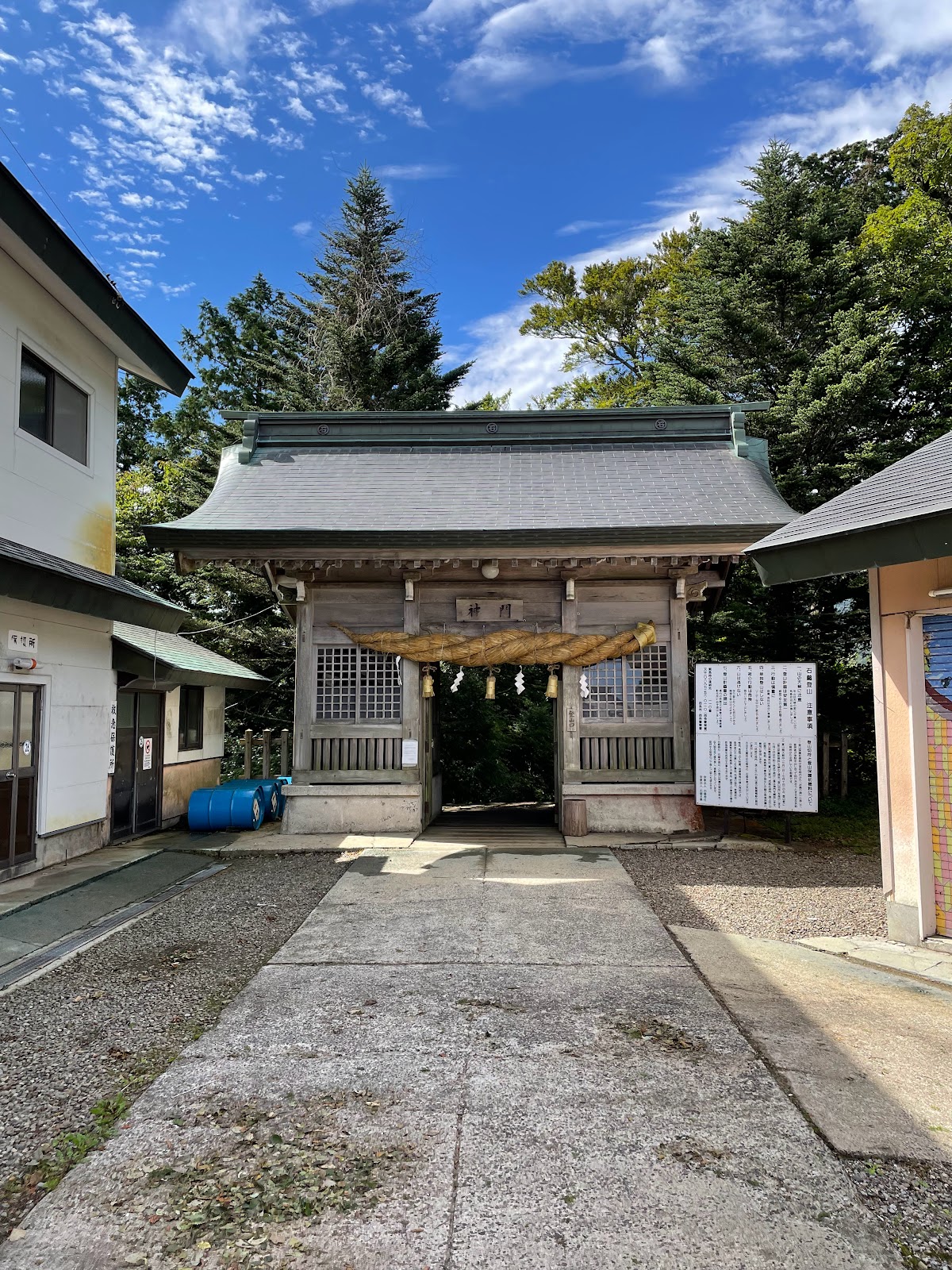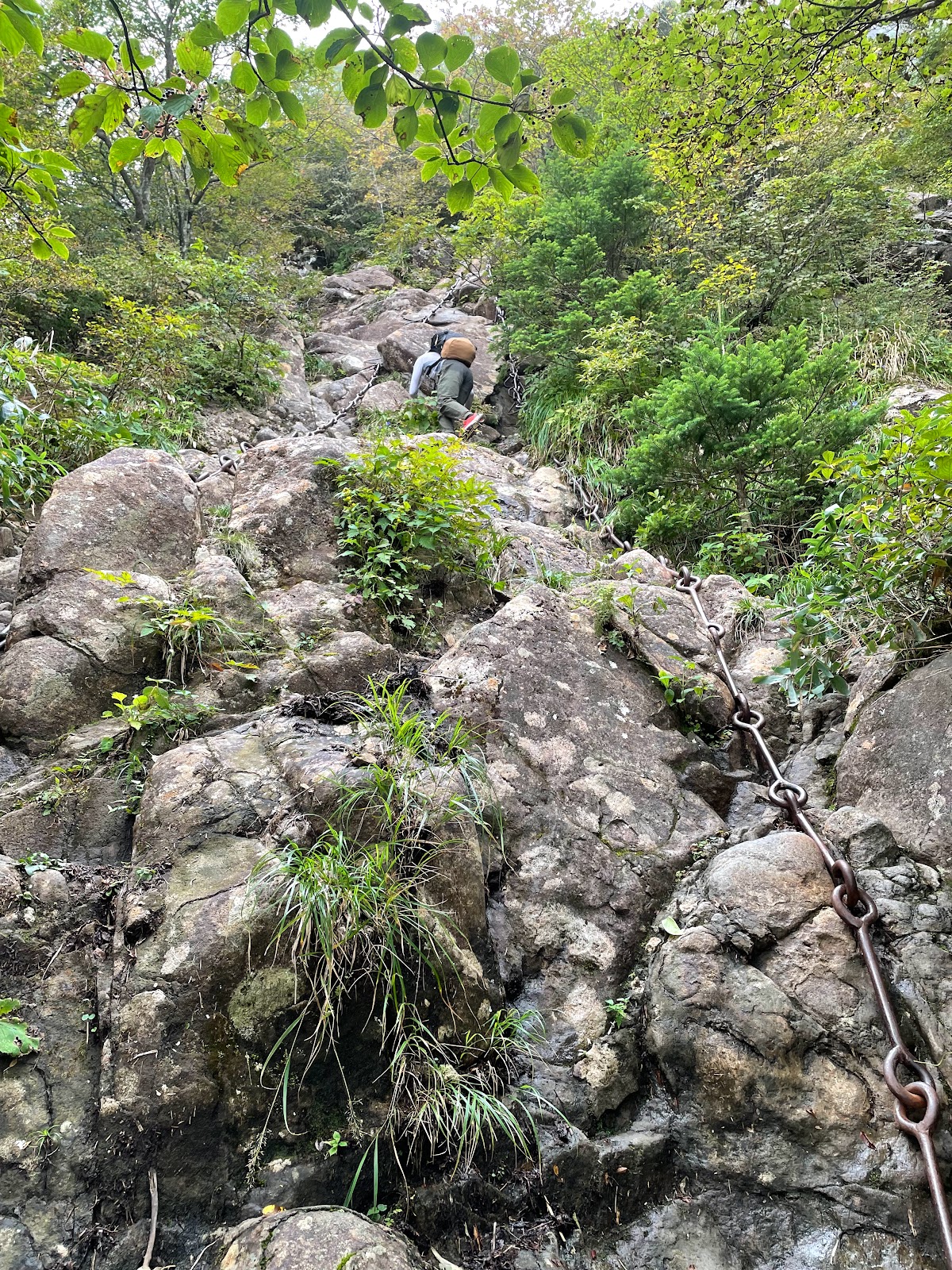Toyohashi Alpine Club
Mountaineering in Japan
9 September 2022
Saijo, Shikoku, Japan
Party: Darren DeRidder
 |
| Ishizuchi-san summit shrine from Tengu-dake |
The end of a summer spent in Japan turned out differently than expected. Not long after I returned from my trip to the North Alps with Iain, I came down with a fever and tested positive for COVID. I'm fairly sure I picked it up in the Karasawa Hutte. By the time I fell sick, my return flight to Canada was only a week away, but I was required to self-isolate for ten days, and had to postpone my departure. There were no affordable flights until mid-September, so my stay in Japan had to be extended by another three weeks. That was also when my visa was set to expire. It was all a huge hassle and sitting alone in a tatami room for ten days was also not at all how I wanted to finish my summer in Japan. It did give me an opportunity to mull over what I might do after I got released from quarantine, however.
I had come to realize that in the sweltering heat of the Japanese summer, there are really only two places I want to be: at the beach or in the mountains. And after the trip up to Kamikochi for an attempted rock climb that was unfortunately stopped by bad weather, I had been struggling with a lingering feeling of disappointment at not having climbed anything noteworthy. Iain, who by this time was back in London, suggested that I might make a trip up to Daisen, or down to one of the notable peaks in Shikoku. My old copy of Paul Hunt's "Hiking in Japan" contained an interesting write-up of Ishizuchi. Its description of chains adorning sheer rock faces sounded intriguing, so a plan came together to go and climb it.
Leaving on a Thursday afternoon from Himeji I took the Sanyo Shinkansen line to Okayama and transferred to a slower train on the Seto-Ohashi line over the impressive series of bridges that also carry the Seto Chuo Expressway, island-hopping all the way from Kansai to Shikoku and onward to Saijo city.
 |
| View from the Seto Bridge |
It was dark by the time I got to Saijo, but the hotel where I had a reservation was mere steps away from the station, so it didn't take long to get checked in. It was after 7pm and a lot of restaurants were already closed, but I came across a casual and trendy looking pub on the main street in front of the station that stayed open late and specialized in Okonomiyaki. I asked for the chef to choose one of the more popular dishes for me, ordered a beer, and enjoyed a really good meal before heading back the hotel and taking a soak in their hot spring bath.
I didn't get a particularly good night's sleep, but was up early to make a quick stop at the convenience store before heading back to the station to get a ticket for the bus that would take me up to the Ishizuchi ropeway. With some time to spare before the bus arrived I took a short stroll around the station area and admired the buildings and views of faraway peaks from a vantage point nearby. In the early morning, Saijo seemed like a pretty if not particularly exciting town.
 |
| Views near Saijo Station |
The bus stop in front of the station wasn't hard to identify since there was already a small gathering of hikers in the shelter, who sat in silence and pretended they didn't notice one another. With a few minutes before the bus was scheduled to arrive, I made one last run over to a nearby drink vendor to get a bottled drink. When I got back, a bus was pulling away but the group of hikers was still sitting in the shelter. Amongst the group were a young fellow in typical street wear, and older gentleman in blue jeans, and like the proverbial rose among thorns, a young lady who was the only one that looked properly dressed for the occasion in proper outdoor gear. The scheduled bus time came and went, and I began to worry that I'd missed my ride, but after a few more minutes the bus to Ishizushi Ropeway came rolling into the terminal area and we all got on board. Winding our way through the town we soon got up into the forested hills and followed a precipitous course along a river valley with impressive views and the odd section of road work, were construction crews were busy shoring up the near-vertical slopes. It looked like dangerous work. Along the way we passed under a house that was clinging to the hillside above the road, and the driver slowed to call out to an old man who was leaning out the window, waving. A couple of sentences were shouted back and forth, with smiles and waves; in such an isolated location I suppose the passing bus was a highlight of the day for the old fellow.
The lower end of the route was the ropeway station, or more precisely, a hovel of roadside shacks leading to a decrepit covered stairway with a very rusty sign over it declaring the entrance to the ropeway. I had hoped to fill my water bottles here at the base of the ropeway, and although running water was present, the staff at the ropeway station said it wasn't drinkable. I'm not entirely sure about that, as most tap-water in Japan is potable and I've never gotten sick drinking from mountain streams there either. I decided to see if I could find a water source at the top end of the ropeway. In the worst case, I understood that there were a few huts along the way where drinks could be purchased. The number of hikers waiting to take the ropeway up had grown beyond the group who had arrived by bus. They included a few folks in flashy running gear.
The ropeway took us quickly up the mountainside, climbing ever more steeply the higher we got. Normally, the idea of taking a ropeway to get partway up a mountain wouldn't appeal to me, but in this case, it avoided hours of what could only be a monotonous, soul-destroying slog up an unforgivingly steep and densely forested slope, and it was the only way to get the route done in one day as a round trip from Saijo. The interesting climbing would begin once we got up out of the deep valley.
At top of the ropeway was a small building with some washrooms, a small shop and a couple of vending machines, and this led out after a short walk to a collection of buildings with little shops and such, which in the busy season are probably in full swing, but appeared to be mostly shut down as I wandered through. I took the opportunity to get a couple of bottled drinks from a vending machine and organize my gear a little before setting off onto the trail, which led through a large shrine gate and, much to my dismay, downwards.
The trail carried on downwards for a good ways, and I started thinking that not only would I have to make up this lost elevation on the way to the summit, but I'd have to be climbing back up this hill on the final stretch of the return trip as well.
I was feeling eager to put some distance under my boots and had pushed ahead of most of the other climbers, which was somewhat pointless considering that the slower-moving hikers always tend to be more consistent and end up arriving at the destination within a few minutes of the speed-hikers anyway. Sure enough I got overheated enough that I needed to stop for a couple of minutes, and was passed by a few of the stronger hikers. Later on I again caught up with a couple of them, including the young lady who looked like the most experienced climber, and we exchanged a bit of small talk before each pushing onwards. The trail got fairly steep and had many sections of crude steps fashioned from tree branches rough-hewn timbers wired together, many of which were collapsed and had to be carefully navigated.
The trail seemed to be pretty wet but true to the guidebook there wasn't any fresh running water to be found along the way. Pressing on I came to a section where large iron "kusari" chains were hanging down a steep rocky section, which the regular hiking trail bypassed on the left. These were the "practice chains" which, it is said, are a suitable test for one's ability to complete the three subsequent sets of chains which are the "real deal". I didn't particularly want to expend my energy on the practice chains, preferring to save my strength for the longer more challenging sections ahead. Later on, I learned that this initial set of chains isn't meant for practice so much as it is as a test to see whether or not you've got what it takes to do the other three sets of chains, and as such, they're quite challenging in their own right.
Somewhere after this a rather steep set of steps led up to a col where a very decrepit old hut was sitting, manned by an old guy who seemed to be mostly ignoring people passing by. There were some drinks for sale, and I took a mental note of that in case on the way back I needed to rehydrate, as the drinks I had purchased lower down were already running low. Following the ridge, the trail emerged out into an flat section of low bamboo grass which provided views in all directions, but unfortunately the clouds obscured what would have otherwise been a spectacular vista.
Although it seemed from the bamboo plateau that there wasn't much higher to go, behind the clouds ahead the true summit of Ishizuchi was hidden in mist, and the real challenges of the climb were about to arrive. There were three sections of near vertical rock down which were hanging these enormous kusari chains. The rock itself provided plenty of footholds in most cases, but in some areas, triangular links like "aiders" had been forged onto the kusari as footholds. The chains themselves were quite polished and didn't provide the most secure feeling. It took some determination to get into the right headspace going up. One of my fellow climbers, who I had started chatting with earlier, led the way and paused to see how I was doing on one of the more difficult sections. Seeing that folks were looking out for one another gave me the encouragement I needed to batman my way up the rest of the chains. Two more sections of chains followed, each longer than the previous, with the final set being nearly 70 meters long.
On the day I climbed Ishizuchi, there were only a couple of folks ahead of me on the chains, and spread out so far that I suppose they reached the end of the chains just as I was beginning them. On a busy day, these chains are reported to be jammed full of people, head to toe, and could be a real train wreck if a single person were to slip and fall, taking everyone else with them. Nevertheless, apparently folks of all ages including kids can be seen scrambling up this mountain during the height of the climbing season.
The last set of chains deposited me near the final summit ridge leading up broad stone steps past a mountain shelter to the shrine at the top of Mt. Ishizuchi. Here there was a broad flat area where a lot of climbers were sitting down to have lunch and take in the views. Between the clouds you could catch glimpses of mountain ridge lines leading off into the distance, bits of blue sky and sea.
The highest peak of Ishizuchi is Tengu-dake, a short scramble further along the ridge. Prior to climbing, I had been studying the map and gotten the mistaken impression that Tengu-dake might be a little too far to include in a one-day round trip climb from Saijo and back, but I asked some of the other climbers how long it took to cross over and they said it only took about 15 minutes. After a short break, I decided to head over, and the young lady with the good climbing gear said she would go as well, so we headed over together. There were a couple of bits that required good balance and steady footing, where I crouched down and scampered across while uttering a mild oath... just enough exposure to keep things interesting.
And then finally I was at the summit of Ishizuchi. Photos were taken, and although the views were mostly obscured by clouds, one side of the mountain had some clear air and view, and looking back across to the Ishizuchi-san shrine the view was really picturesque. Small figures could be seen picking their way along the ridge towards us as we headed back.

On the way back down, the sections of chains can thankfully be bypassed by some very robust sections of aluminum scaffold and stairs, and my defacto climbing partner, who turned out to be from Taiwan, kept me company for most of the way down. She had memorized the ropeway and bus timetable for the trip back to Saijo, where we both were headed, so we chatted most of the back to the ropeway station and I got to hear about various mountains of the Nihon Hyakumeizon that she had climbed or was planning to. The trip back home was long but uneventful, and I was really glad to have climbed something before the end of my extended Japan stay. Ishizuchi was actually a lot of fun - not a high mountain, but challenging and with an interesting character. It helped me to appreciate that there are mountains not in the 3000 meter plus category that nevertheless are very enjoyable to climb, and that plenty of good climbing opportunities exist without having to go all the way to the Kita or Minami Alps. The idea of sorting out other future objectives based on the "100 Famous Mountains of Japan" book started to take shape, and luckily for me, when I arrived back in Canada a couple of days later, a copy of that book was waiting for me in the mailbox. Iain had kindly sent me a copy, and it provided excellent reading through the cold Canadian winter, firing my imagination for future sunny days in the mountains of Japan.












